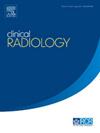基于开源计算机断层扫描(CT)的可疑附件肿块女性肌肉减少症评估:可行性和可重复性研究
IF 1.9
3区 医学
Q2 RADIOLOGY, NUCLEAR MEDICINE & MEDICAL IMAGING
引用次数: 0
摘要
子宫内膜癌是最致命的妇科恶性肿瘤,其预后与诊断时的分期有关。超声检查是评估附件肿块的一线工具,而计算机断层扫描(CT)支持分期和手术计划。骨骼肌减少-骨骼肌质量低是肿瘤的预后因素,可在常规CT上测量。它在患有不确定或恶性附件肿块的女性中的作用尚不清楚。本研究旨在评估在该人群中使用开源软件进行基于ct的肌肉减少症分析的可行性、可重复性和临床实用性。材料和方法在这项前瞻性先导研究中,38名患有可疑附件肿块(根据国际卵巢肿瘤分析简单规则、卵巢-附件报告和数据系统或主观评估分类为不确定或恶性)的女性接受了基于ct的肌肉减少症分析。使用3D切片机对L3层轴向CT图像进行分割。计算骨骼肌指数(SMI, cm²/m²),骨骼肌减少症定义为SMI <;38.5 cm2/m2。观察者间的一致是用布兰德-奥特曼情节和科恩的卡帕来评估的。使用卡方检验相关性,并通过敏感性、特异性、预测值、似然比和受试者工作特征曲线下面积评估恶性肿瘤预测的诊断性能。结果肌少症分析可行,重现性好(κ = 0.839)。与肿瘤晚期(P = 0.028)和腹膜癌(P = 0.033)有显著相关性,但与组织病理学恶性肿瘤、淋巴结病变、邻近浸润或怀疑其他原发肿瘤无显著相关性。恶性肿瘤预测的诊断效能有限。结论利用开源软件进行基于ct的肌少症分析是可行且可重复性好的。尽管与疾病晚期相关,但肌肉减少症并不能提高恶性肿瘤的预测,因此不应作为术前风险分层的指导。它的潜在价值可能在于确定在治疗前可以从康复或有针对性的营养支持中受益的患者。本文章由计算机程序翻译,如有差异,请以英文原文为准。
Open- source computed tomography (CT)-based sarcopenia assessment in women with suspicious adnexal masses: a feasibility and reproducibility study
Aim
Ovarian cancer is the most lethal gynecologic malignancy, with prognosis linked to stage at diagnosis. Ultrasonography is the first-line tool for adnexal mass evaluation, while computed tomography (CT) supports staging and surgical planning. Sarcopenia—low skeletal muscle mass—is a prognostic factor in oncology and measurable on routine CT. Its role in women with indeterminate or malignant adnexal masses remains unclear. This study aimed to assess the feasibility, reproducibility, and clinical utility of CT-based sarcopenia analysis using open-source software in this population.
Materials and Methods
In this prospective pilot study, 38 women with suspicious adnexal masses (classified as indeterminate or malignant by International Ovarian Tumor Analysis Simple Rules, Ovarian-Adnexal Reporting and Data System, or subjective assessment) underwent CT-based sarcopenia analysis. Axial CT images at the L3 level were segmented using 3D Slicer. Skeletal muscle index (SMI, cm²/m²) was calculated, with sarcopenia defined as SMI <38.5 cm2/m2. Interobserver agreement was evaluated with Bland–Altman plots and Cohen’s kappa. Associations were tested using chi-square, and diagnostic performance for malignancy prediction was assessed by sensitivity, specificity, predictive values, likelihood ratios, and area under the receiver operating characteristic curve.
Results
Sarcopenia analysis was feasible and reproducible (κ = 0.839). Significant associations were observed with advanced tumor stage (P = .028) and peritoneal carcinomatosis (P = .033), but not with histopathological malignancy, lymphadenopathy, adjacent invasion, or suspicion of alternative primary tumor. Diagnostic performance for malignancy prediction was limited.
Conclusion
CT-based sarcopenia analysis using open-source software is feasible and reproducible. Although associated with advanced disease, sarcopenia did not enhance malignancy prediction and should not guide preoperative risk stratification. Its potential value may lie in identifying patients who could benefit from prehabilitation or targeted nutritional support before treatment.
求助全文
通过发布文献求助,成功后即可免费获取论文全文。
去求助
来源期刊

Clinical radiology
医学-核医学
CiteScore
4.70
自引率
3.80%
发文量
528
审稿时长
76 days
期刊介绍:
Clinical Radiology is published by Elsevier on behalf of The Royal College of Radiologists. Clinical Radiology is an International Journal bringing you original research, editorials and review articles on all aspects of diagnostic imaging, including:
• Computed tomography
• Magnetic resonance imaging
• Ultrasonography
• Digital radiology
• Interventional radiology
• Radiography
• Nuclear medicine
Papers on radiological protection, quality assurance, audit in radiology and matters relating to radiological training and education are also included. In addition, each issue contains correspondence, book reviews and notices of forthcoming events.
 求助内容:
求助内容: 应助结果提醒方式:
应助结果提醒方式:


